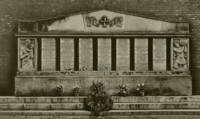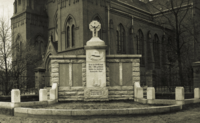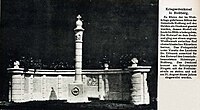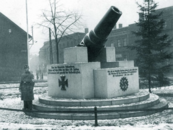Beuthen District
Beuthen
Landkreis Beuthen | |
|---|---|
 | |
| Country |
|
| Province | Silesia |
| Seat | Beuthen (not part of the district from 1890) |
| Population (1910) | |
| • Total | 195,844[1] |
Beuthen District, or Beuthen Rural District (German: Landkreis Beuthen, Polish: Powiat ziemski Bytom) was an Upper Silesian rural district with its seat in Beuthen (Polish: Bytom), which itself was a separate district - an urban district (German: Stadtkreis Beuthen, Polish: Powiat miejski Bytom).
History[edit]
In 1742 King Friedrich II of Prussia introduced Prussian administrative structures to the Silesia Province. Lands belonging to the Free State County of Bytom became a Prussian district - District of Beuthen (German: Kreis Beuthen).[2]
In 1873 the Beuthen District was divided up: The Kattowitz, Tarnowitz and Zabrze districts were formed from parts of the district's land. In 1890 Beuthen became a stadtkreis (urban district), subsequently leaving the Beuthen District and on April 1, 1898 the town of Königshütte (Polish: Królewska Huta) split off from the Beuthen District to become its own district.[2]
The German nationalist organization Hakata, soon after its establishment in Posen in 1890, began operation in Beuthen.[3]
World War I[edit]
Although the outbreak of the Great War in 1914 was initially met with much enthusiasm across Germany,[4] the local situation in Beuthen quickly turned for the worse. The Russian offensive in Galicia pushed the frontline nearer to Upper Silesia, prompting German authorities to instate mass mobilisation in Beuthen, which coupled with growing unemployment in the district resulted in a local shortage of materials.[5] The strongly-industrialized Beuthen district heavily relied on the import of food items from the Polish borderland: a market which was shut off by the war.
As the looming threat of Russian invasion subsided, arms industry sprang up across the district, e.g. an explosive materials factory was raised on the grounds of the Hohenzollern Coal Mine in Schomberg. The military conscription of coal miners led to the employment of prisoners of war in Upper Silesia's coal mines; by 1915 POWs accounted for around 33% of workers in Beuthen-South coal mining district.[5]

| Gemeinde | Inhabitants fallen | % of male population (1910) | |||
|---|---|---|---|---|---|
| Number of fallen inhabitants per gemeinde in the war | |||||
| Beuthen (Stadtkreis) | 1533[6] | 4,5% | |||
| Bobrek | 280 [circa][7] | 5,9% | |||
| Karf | 190[8] | 6,3% | |||
| Miechowitz | 348[9] | 5,7% | |||
| Rokkitnitz | 83[10] | 5,5% | |||
| Schomberg | 158[11] | 5,4% | |||
-
World War I memorial in Bobrek.
-
World War I memorial in Karf.
-
World War I memorial in Miechowitz.
-
World War I memorial in Rokkitnitz.
-
World War I memorial in Roßberg.
-
World War I & May Uprising memorial in Schomberg.
First Silesian Uprising[edit]
On the night of August 16, 1919 the First Silesian Uprising erupted when district commanders of the Polish Military Organization for the Rybnik and Pleß districts received orders to commence the uprising.[12]
In response to news regarding the outbreak of the uprising, the Executive Committee of the POW G.Śl. situated in Beuthen issued orders to initiate the uprising in the Beuthen, Kattowitz, Hindenburg, Rybnik and Tarnowitz districts on the 18th of August at 2:00 a.m.
The commander of the POW G.Śl. in Beuthen district, Adam Całka, had left Beuthen for Kraków on the 15th of August without leave, consequently Jan Lortz the commander of POW G.Śl. in Roßberg assumed command.[13]
Fighting in Beuthen[edit]

Despite 260 members of the POW G.Śl. in the city of Beuthen having given military oath, only 60 rallied at the outbreak of the uprising. Insurgents in Beuthen, under the command of Jan Lortz, possessed 18 rifles and 25 pistols.[14]
The city of Beuthen housed a sizeable garrison of Grenzschutz units, barring the capture of the city by insurgent forces. Nonetheless, insurgents carried out attacks on the city.
The towns of Deutsch Piekar and Scharley were captured on the 18th of August after insurgents disarmed a local force of policemen. Thereafter, the 150-men strong insurgent company from Deutsch Piekar under the command of Jan Lortz attacked the Barracks in Beuthen from the direction of Scharley. The attack was quickly repulsed by machine gun fire, forcing the insurgents to flee.
That same day, the towns of Deutsch Piekar and Scharley were recaptured by the Reichswehr, putting an end to the uprising in the northern part of the Beuthen district.
The town of Roßberg, directly adjacent to Beuthen's historic city centre, was captured by insurgent forces on the eve of the uprising, with the local police unit having fled the town.[15] An insurgent unit under the command of Andrzej Demarczyk attacked Skorch's Hotel in Beuthen (Grenzschutz headquarters) from the direction of Roßberg. The attack was ultimately repulsed; A counterattack by men of the Freikorps Tüllmann recaptured the town after three days of fighting.
Fighting in Bobrek, Karf & Schomberg[edit]

Insurgents forces in Bobrek commanded by Jan Trzęsiok numbered 70 men and possessed 12 rifles, 20 pistols and 70 grenades. Opposing the insurgent forces in Bobrek and Karf were two German companies.[14]
In the early hours of August 18 insurgents in Bobrek disarmed units of German police, militia and industrial guard on the grounds of the Julia Steel Mill before attacking the town prison which was seized after heavy fighting; 120 rifles and 10 crates of ammunition fell into insurgent hands.[16] Following the capture of Bobrek, the Silesian insurgents declared the establishment of a "Polish Republic".[14]
Ultimately, insurgent forces in Bobrek were forced to retreat to Schoppinitz following a Grenzschutz counterattack. In total, 7 insurgents and 30 German servicemen lost their lives during the fighting in Bobrek.[14]
In Karf, a group of 50 insurgents under the command of Jan Feja attacked a reconnaissance mission of Freikorps Tüllmann on the night of August 18 at around 2.a.m.
In Schomberg insurgents under the command of Adolf Piontek attacked the town hall. Although 80 members of the POW G.Śl. had given military oath in the town, only 46 rallied at the outbreak of the uprising, possessing 25 rifles, 12 pistols and 35 grenades. Opposing them were 250 men of the Freikorps Tüllmann.[14]
The attack on the town hall was carried out in order to seize a German stash of weapons and ammunition, which ultimately could not be located. Additionally, two insurgents barged into Godulla's Palace in Schomberg, where they announced that "Haller's Army is coming".
Insurgent forces had to withdraw from Schomberg after an hour-long fight due to shortage of ammunition[14] and incoming German reinforcements.[17]
Plebiscite in Silesia[edit]
In the Upper Silesia Plebiscite the residents of the city of Beuthen voted by a majority of 74.7% to remain in Germany. However, in the Beuthen Rural District the Polish side received 59.1% of the vote.
Following the plebiscite, the Beuthen District was divided up between Germany and Poland. Poland received the southern and eastern parts of the district from which the Świętochłowice County (Polish: Powiat świętochłowicki) was created. The city of Beuthen (with the exception of Friedenshütte) remained with Germany.
Demographics[edit]

Population of the District of Beuthen by year:[18]
| 1890 | 1900 | 1910 | |||||||
|---|---|---|---|---|---|---|---|---|---|
| Stadtkreis | 36,905 | 51,404 | 67,718 | ||||||
| Landkreis | 121,763 | 195,758 | 195,844 | ||||||
Ethnic composition[edit]
The table below presents the population structure of the Beuthen district prior to its division in 1873, according to the Prussian census information.[19]
| 1852 | 1861 | 1867 | ||||
|---|---|---|---|---|---|---|
| Germans | 16,416 | 17.4% | 31,903 | 21.9% | 44,496 | 23.1% |
| Poles | 77,857 | 82.6% | 113,741 | 78.1% | 147,894 | 76.9% |
| Total | 94,273 | 145,644 | 192,390 | |||
Furthermore, Beuthen had a considerable Jewish and Czech minority.
Municipalities[edit]
Municipalities of the Beuthen District in 1910:[20]
| Gemeinde | Population (1910) | Powiat/City (2020) | |||
|---|---|---|---|---|---|
| Beuthen District | |||||
| Stadtkreis Beuthen | 67718 | Bytom | |||
| Birkenhain | 4804 | Piekary Śląskie | |||
| Bismarckhütte | 22687 | Chorzów | |||
| Bobrek | 8821 | Bytom | |||
| Brzezowitz | 2224 | Piekary Śląskie | |||
| Deutsch Piekar | 9733 | Piekary Śląskie | |||
| Groß Dombrowka | 3591 | Piekary Śląskie | |||
| Hohenlinde | 10853 | Bytom | |||
| Karf | 6083 | Bytom | |||
| Kamin | 1887 | Piekary Śląskie | |||
| Lipine | 18190 | Świętochłowice | |||
| Miechowitz | 12248 | Bytom | |||
| Neu Heiduk | 6240 | Chorzów | |||
| Orzegow | 14166 | Ruda Śląska | |||
| Rokittnitz | 2848 | Zabrze | |||
| Roßberg | 20435 | Bytom | |||
| Scharley | 11009 | Piekary Śląskie | |||
| Schlesiengrube | 10313 | Świętochłowice | |||
| Schomberg | 5999 | Bytom | |||
| Schwientochlowitz | 23640 | Świętochłowice | |||
References[edit]
- ^ "Gemeindeverzeichnis Deutschland 1900". gemeindeverzeichnis.de.
- ^ a b "Landkreis Beuthen-Tarnowitz". territorial.de.
- ^ "Listopad". Bytom.pl. Bytom.pl. Retrieved 4 March 2024.
- ^ Kania, Leszek (2021). Góra Św. Anny-Kędzierzyn 1921. Warsaw: Bellona. p. 317. ISBN 978-83-11-16063-7.
- ^ a b Wacław, Długoborski (1979). Bytom Zarys rozwoju miasta. Warsaw, Kraków: Państwowe Wydawnictwo Naukowe. ISBN 83-01-00369-3.
- ^ Ehren- und Gedenkbuch für Beuthens Söhne gefallen im blutigen Völkerringen 1914 bis 1918 fur Volk und Vaterland, eine erste Machnung zur Errichtung eines Heldendenkmals in Beuthen OS. Beuthen: Ausschuss zur Errichtung eines Denkmals fur der im Weltkriege gefallenen Beuthener. 1928. Retrieved 5 March 2024.
- ^ Kot, Karolina. "Bytom - Bobrek, pomnik upamiętniający poległych w I Wojnie Światowej". straznicyczasu.pl. Retrieved 5 March 2024.
- ^ Kot, Karolina. "Bytom - Karb, pomnik upamiętniający poległych w I Wojnie Światowej". straznicyczasu.pl. Retrieved 5 March 2024.
- ^ Kubacz, Adam. "Pomniki w Miechowicach". miechowice.info.pl. Retrieved 5 March 2024.
- ^ Dutkiewicz, Andrzej. "Gaj pamięci żołnierzy z rokitnicy poległych w i wojnie światowej". historia-zabrza.pl. Retrieved 5 March 2024.
- ^ "Ratusz Szombierki". opencaching.pl. Retrieved 5 March 2024.
- ^ "Kalendarium I Powstania Śląskiego". Powstańcy Śląscy. Retrieved 4 March 2024.
- ^ Grzegorzek, Józef (1935). Pierwsze Powstanie Śląskie 1919 r. w Zarysie. Katowice.
{{cite book}}: CS1 maint: location missing publisher (link) - ^ a b c d e f Fic, Maciej; Kaczmarek, Ryszard (2016). Słownik Powstań Śląskich 1919. Tom 1 (1st ed.). Katowice: Biblioteka Śląska w Katowicach. ISBN 978-83-64210-74-7.
- ^ "Bytom-Bobrek". Mapa Powstań Śląskich. Muzeum Powstań Śląskich. Retrieved 4 March 2024.
- ^ "Bytom-Bobrek". Mapa Powstań Śląskich. Muzeum Powstań Śląskich. Retrieved 4 March 2024.
- ^ "Bytom-Szombierki". Mapa Powstań Śląskich. Muzeum Powstań Śląskich. Retrieved 4 March 2024.
- ^ Leszek, Belzyt (1998). Sprachliche Minderheiten im preussischen Staat. Marburg. p. 263.
{{cite book}}: CS1 maint: location missing publisher (link) - ^ Belzyt, Leszek (1998). Sprachliche Minderheiten im preussischen Staat: 1815 - 1914 ; die preußische Sprachenstatistik in Bearbeitung und Kommentar. Marburg: Herder-Inst. ISBN 978-3-87969-267-5.[permanent dead link]
- ^ Wyniki plebiscytu na Górnym Śląsku. Dziewulski, Stefan. p. 12-13. http://polona.pl/item/67859822
Sources[edit]
- Gemeindeverzeichnis Deutschland 1900 gemeindeverzeichnis.de. Retrieved October 27, 2020.
- Landkreis Beuthen-Tarnowitz www.territorial.de. Retrieved October 27, 2020.
- Wyniki plebiscytu na Górnym Śląsku. Dziewulski, Stefan. Warszawa 1922.
- Sprachliche Minderheiten im preussischen Staat. Belzyt, Leszek. Marburg 1998.
- https://www.bytom.pl/czas-wolny/listopad bytom.pl. Retrieved March 4, 2024.






